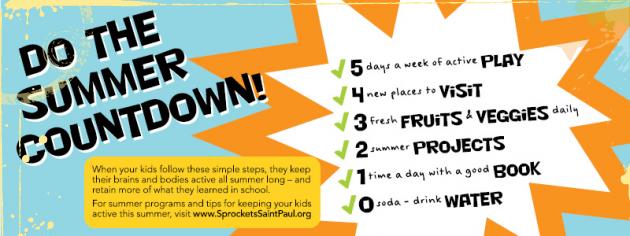Research shows that reading over the summer not only helps prevent summer learning loss, it also helps young people become better readers, writers and spellers.
According to the American Library Association, summer reading is especially important in helping to close the achievement gap. That’s because summer learning loss is cumulative. Children don’t “catch up” with their peers in the fall, as the other children have moved ahead with their skills.
Make Reading A Priority This Summer
- Spend time every day reading with your young child, either listening to them read or reading aloud to them.
- For many families, a book before bedtime makes sense, but look for opportunities to build reading into other parts of your day too. What about a stack of books at the breakfast table? Or tucked into the side pockets of a car door? Small paperbacks can easily slip into purses, backpacks, and even lunch sacks.
- Let your children see you spending time reading – whether it’s a book, newspaper or favorite magazine. Seeing parents and other adults interested in reading helps foster a life-long love of reading and books among young people.
- If your child is ready, let them sign up for their own library card. This instills a sense of pride and ownership, even in very young children.
- Consider purchasing an age and interest-appropriate magazine subscription for your child. Or, find a friend or caring adult who wants to be “summer pen pals.” The fun “surprise” of getting mail addressed right to your child can help spark interest in reading.
Library SummerPrograms Make a Difference
Kids and teens really benefit from summer reading programs and summer spark activities, like the one offered through the Saint Paul Public Library. Research shows that children who participate in a public library summer reading program have higher reading scores by third grade than children who do not participate. There are also a number of free fun programs at every Saint Paul Public Library Location.
More Tips, Tricks and Tidbits
- Let your child choose the books. Follow their interests and encourage new interests. Ask other parents, librarians and other kids for ideas on books they recommend.
- It’s okay to take a break from the written text. Try setting the book down for a moment to act out a scene from the story you are reading. Or, ask your child questions about the story, like “What do you think will happen next?” Let your child peek ahead a few pages to look at the pictures and guess what will happen next in the story.
- Use inflection — a deep voice for one character, high-pitched and squeaky for another — to make the story interesting and fun.
- Read the same books again and again. And again. Kids love repetition, in fact, that’s one of the ways they learn about their world. Give your child a “role” in a familiar story by having them recite favorite lines of dialogue.
- Point to words as you read them. This demonstrates pre-reading concepts, like the simple fact that words make up the story, and that English is read from left to right, top to bottom.
- Cuddle into a favorite chair or comfy spot while you read. Snuggling close while reading helps children form a positive feeling about reading in general.
Want to know more?
The Minnesota Humanities Center has “Tips on Reading with Children” available in 26 (yes, 26!) different languages on their web site.
For more ideas on raising a life-long reader, visit Commonsensemedia's "How to Raise a Reader"
The American Library Association offers these tips on reading with your children.

